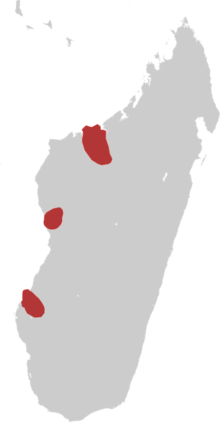| Revision as of 13:18, 10 November 2021 editKeith D (talk | contribs)Autopatrolled, Administrators544,758 edits Fix cite date errorTag: AWB← Previous edit | Revision as of 22:50, 11 November 2021 edit undoMonkbot (talk | contribs)Bots3,695,952 editsm Task 19: convert/update IUCN references to {{cite iucn}} using data from IUCN Red List API; IUCN status confirmed; IUCN status ref updated ; evaluated 1 reference; 1 reference modified; (3/00:06.84);Tag: AWBNext edit → | ||
| Line 5: | Line 5: | ||
| | status = EN | | status = EN | ||
| | status_system = IUCN3.1 | | status_system = IUCN3.1 | ||
| | status_ref = <ref name= |
| status_ref = <ref name="iucn status 11 November 2021">{{cite iucn |author=BirdLife International |date=2016 |title=''Zapornia olivieri'' |volume=2016 |page=e.T22692654A93363104 |doi=10.2305/IUCN.UK.2016-3.RLTS.T22692654A93363104.en |access-date=11 November 2021}}</ref> | ||
| | genus = Zapornia | | genus = Zapornia | ||
| | species = olivieri | | species = olivieri | ||
| Line 14: | Line 14: | ||
| }} | }} | ||
| The '''Sakalava rail''' (''Zapornia olivieri'') is a species of bird in the family ]. It is endemic to western ]. This bird is small with brown upperpart feathers, grey underparts, a yellow bill and red legs.<ref name=" |
The '''Sakalava rail''' (''Zapornia olivieri'') is a species of bird in the family ]. It is endemic to western ]. This bird is small with brown upperpart feathers, grey underparts, a yellow bill and red legs.<ref name="iucn status 11 November 2021" /> | ||
| The ] of this rail species is freshwater ]es of reed ''Phragmites mauritianus''.<ref name=":1">{{Cite journal|last=Rabenandrasana|first=Marc|last2=Zefania|first2=Sama|last3=Long|first3=Peter|last4=The Seing|first4=Sam|last5=Clémentine Virginie|first5=Marie|last6=Randrianarisoa|first6=Mihaja|last7=Safford|first7=Roger|last8=Székely|first8=Tamas|date=March 2009|title=Distribution, habitat and status of ‘Endangered’ Sakalava Rail of Madagascar|url=https://www.cambridge.org/core/product/identifier/S0959270908008058/type/journal_article|journal=Bird Conservation International|language=en|volume=19|issue=1|pages=23–32|doi=10.1017/S0959270908008058|issn=0959-2709}}</ref> It is classified as Endangered and is threatened by ] due to the destruction of wetlands in Madagascar.<ref name=":2">{{Cite book|last=Rabenandrasana|first=Marc|title=Conservation biology of Sakalava rail Amaurornis olivieri an Endangered Malagasy water bird and public awareness in Besalampy wetlands complex, Western Madagascar|publisher=Ligue Malgache pour la Protection des Oiseaux|year=February 2007|location=Antananarivo, Madagascar}}</ref> | The ] of this rail species is freshwater ]es of reed ''Phragmites mauritianus''.<ref name=":1">{{Cite journal|last=Rabenandrasana|first=Marc|last2=Zefania|first2=Sama|last3=Long|first3=Peter|last4=The Seing|first4=Sam|last5=Clémentine Virginie|first5=Marie|last6=Randrianarisoa|first6=Mihaja|last7=Safford|first7=Roger|last8=Székely|first8=Tamas|date=March 2009|title=Distribution, habitat and status of ‘Endangered’ Sakalava Rail of Madagascar|url=https://www.cambridge.org/core/product/identifier/S0959270908008058/type/journal_article|journal=Bird Conservation International|language=en|volume=19|issue=1|pages=23–32|doi=10.1017/S0959270908008058|issn=0959-2709}}</ref> It is classified as Endangered and is threatened by ] due to the destruction of wetlands in Madagascar.<ref name=":2">{{Cite book|last=Rabenandrasana|first=Marc|title=Conservation biology of Sakalava rail Amaurornis olivieri an Endangered Malagasy water bird and public awareness in Besalampy wetlands complex, Western Madagascar|publisher=Ligue Malgache pour la Protection des Oiseaux|year=February 2007|location=Antananarivo, Madagascar}}</ref> | ||
| == Description == | == Description == | ||
| Sakalava Rail measures 19 cm with grey underparts, a yellow bill and red eyes.<ref name=" |
Sakalava Rail measures 19 cm with grey underparts, a yellow bill and red eyes.<ref name="iucn status 11 November 2021" /> This rail species exhibits some evidence of ] of different body size and colours. Males are smaller, thinner, have rufous brown upperparts and bright red shanks.<ref name=":2" /> Females are larger, have brown green upperparts and pale pink shanks. Juvenile and immature Sakalava Rails look very similar to females.<ref name=":2" /> Additional research is needed to confirm sexual dimorphism using DNA or voice analysis.<ref name=":2" /> | ||
| == Habitat == | == Habitat == | ||
Revision as of 22:50, 11 November 2021
Species of bird
| Sakalava rail | |
|---|---|
| Conservation status | |
 Endangered (IUCN 3.1) | |
| Scientific classification | |
| Domain: | Eukaryota |
| Kingdom: | Animalia |
| Phylum: | Chordata |
| Class: | Aves |
| Order: | Gruiformes |
| Family: | Rallidae |
| Genus: | Zapornia |
| Species: | Z. olivieri |
| Binomial name | |
| Zapornia olivieri (G. Grandidier & Berlioz, 1929) | |

| |
| Distribution of the Sakalava rail | |
| Synonyms | |
|
Amaurornis olivieri (Grandidier & Berlioz, 1929) | |
The Sakalava rail (Zapornia olivieri) is a species of bird in the family Rallidae. It is endemic to western Madagascar. This bird is small with brown upperpart feathers, grey underparts, a yellow bill and red legs.
The habitat of this rail species is freshwater marshes of reed Phragmites mauritianus. It is classified as Endangered and is threatened by habitat loss due to the destruction of wetlands in Madagascar.
Description
Sakalava Rail measures 19 cm with grey underparts, a yellow bill and red eyes. This rail species exhibits some evidence of sexual dimorphism of different body size and colours. Males are smaller, thinner, have rufous brown upperparts and bright red shanks. Females are larger, have brown green upperparts and pale pink shanks. Juvenile and immature Sakalava Rails look very similar to females. Additional research is needed to confirm sexual dimorphism using DNA or voice analysis.
Habitat
Sakalava Rail lives in marshes of open water and dense reedbeds of Phragmites mauritianus. These lotic marshes also contain many floating plant species such as native ferns (Salvinia), water lilies (Nymphaea lotus and Nymphaea nouchali) and invasive water hyacinths (Eichhornia crassipes).
References
- ^ BirdLife International (2016). "Zapornia olivieri". IUCN Red List of Threatened Species. 2016: e.T22692654A93363104. doi:10.2305/IUCN.UK.2016-3.RLTS.T22692654A93363104.en. Retrieved 11 November 2021.
- ^ Rabenandrasana, Marc; Zefania, Sama; Long, Peter; The Seing, Sam; Clémentine Virginie, Marie; Randrianarisoa, Mihaja; Safford, Roger; Székely, Tamas (March 2009). "Distribution, habitat and status of 'Endangered' Sakalava Rail of Madagascar". Bird Conservation International. 19 (1): 23–32. doi:10.1017/S0959270908008058. ISSN 0959-2709.
- ^ Rabenandrasana, Marc (February 2007). Conservation biology of Sakalava rail Amaurornis olivieri an Endangered Malagasy water bird and public awareness in Besalampy wetlands complex, Western Madagascar. Antananarivo, Madagascar: Ligue Malgache pour la Protection des Oiseaux.
{{cite book}}: CS1 maint: year (link)
External links
| Taxon identifiers | |
|---|---|
| Amaurornis olivieri | |
This Gruiformes-related article is a stub. You can help Misplaced Pages by expanding it. |